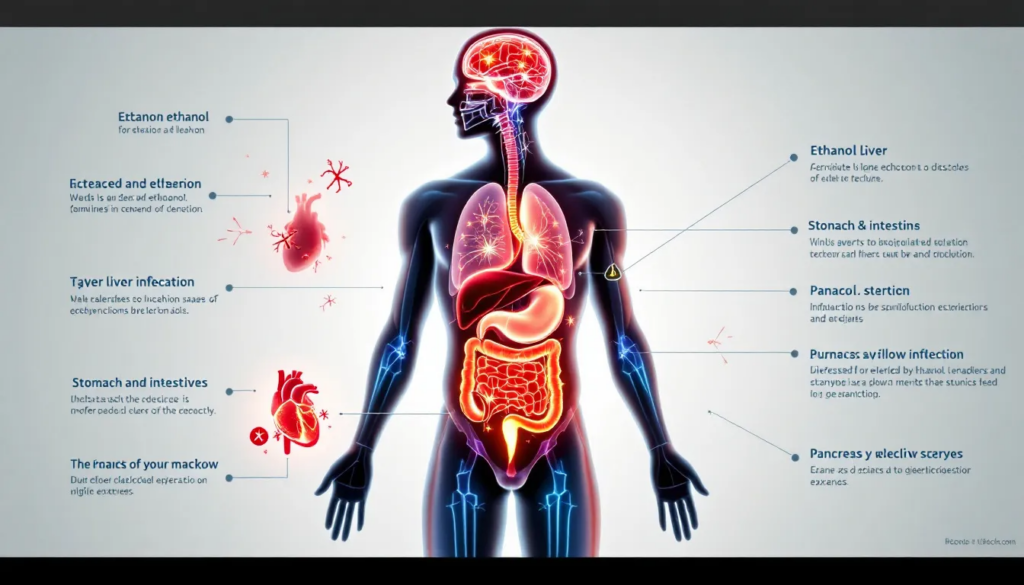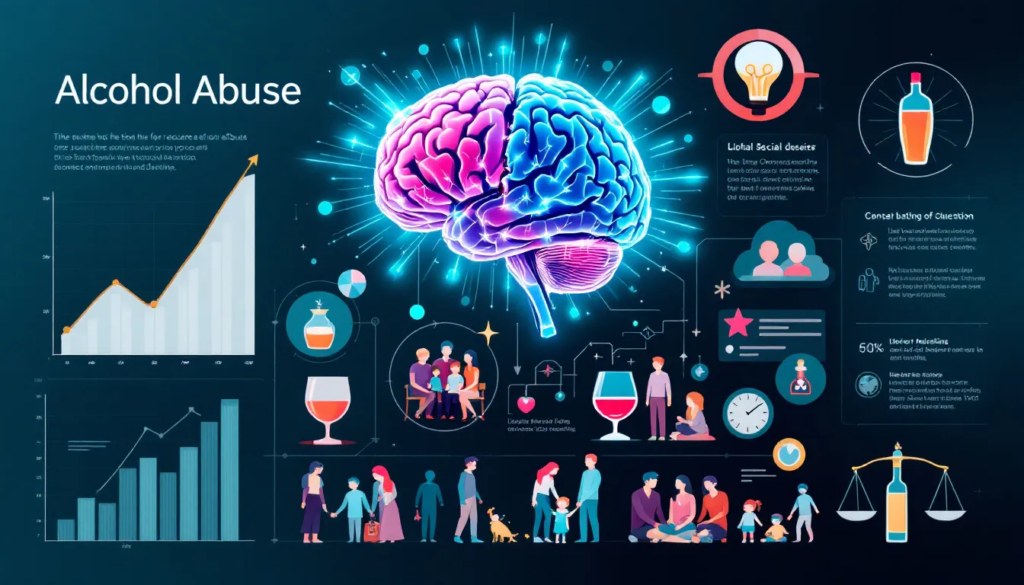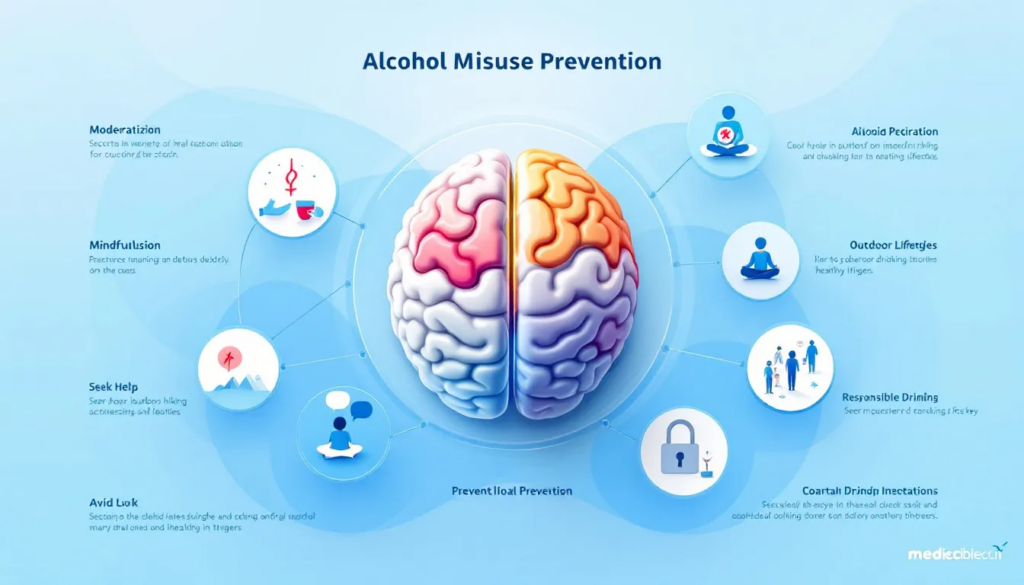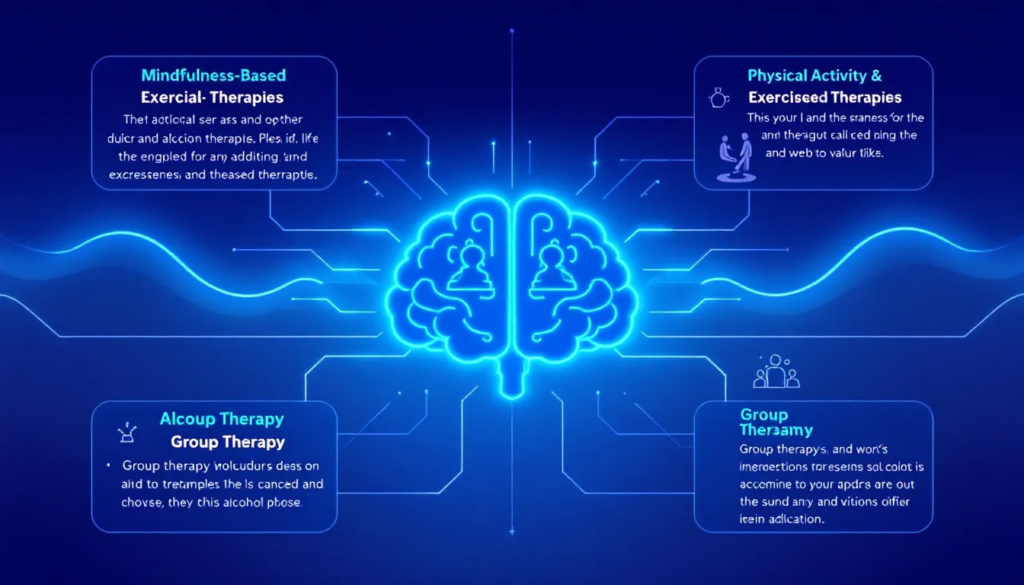EtOH, the medical abbreviation for ethanol (EtOH ethanol), commonly known as alcohol, is often used to describe alcohol consumption in medical settings. This article dives into what the EtOH medical abbreviation means, its effects, and the risks involved.
It’s important to distinguish between ethanol, which is safe for consumption, and other types of alcohol like isopropanol, commonly known as rubbing alcohol, which is toxic and dangerous if ingested.
Key Takeaways
- EtOH is the abbreviation for ethanol, a central nervous system depressant linked to both acute and chronic health issues.
- Chronic ethanol use can lead to severe health problems, including liver disease, cognitive impairments, and increased cancer risk.
- Early identification of Alcohol Use Disorder (AUD) symptoms and effective treatment options are crucial for recovery and managing alcohol addiction.
Introduction to EtOH
EtOH, or ethanol, is a type of alcohol found in alcoholic beverages, with the chemical formula C2H5OH. It is a clear, colorless liquid with a distinctive odor and a mildly sweet flavor. EtOH is present in various forms of alcoholic drinks, including beer, wine, and spirits. Understanding EtOH is crucial in addressing issues related to alcohol abuse, alcohol addiction, and alcohol use disorder (AUD). The effects of EtOH can be both short-term and long-term, impacting physical and mental health, relationships, and overall well-being. Consuming too much ethanol can lead to immediate and serious consequences, such as dangerous behaviors or alcohol poisoning, and over time, it can harm the central nervous system and vital organs.
What Does EtOH Stand For?

Ethanol, denoted chemically as EtOH, is the type of alcohol present in drinks such as beer, wine, and spirits. In the medical field, healthcare professionals use “EtOH” to specifically identify ethanol among other alcohols like methanol or isopropanol. When documenting alcohol consumption or its physiological impacts in a clinical setting—such as noting levels found within blood or tissue—the term EtOH frequently appears on lab results and health records.
As an ingredient commonly found in alcoholic beverages and drinks across various cultures, ethanol acts as a depressant for the central nervous system. This can lead to immediate problems such as acute intoxication and long-term issues related to chronic usage. For those working in healthcare contexts, grasping this chemical abbreviation is essential because it covers an array of consequences stemming from ingesting this substance.
The terminology surrounding etoh addiction encompasses all aspects that are associated with hazardous drinking behaviors—from fatal cases of alcohol poisoning caused by excessive short-term ingestion to enduring bodily harm due to persistent overconsumption—which form core components when discussing conditions linked with regular abuse among medical experts.
How Ethanol Affects the Body

Ethanol has a variety of effects on the body, influencing different organs and systems with both immediate and prolonged outcomes. The initial impacts of ethanol typically include impaired judgment and reduced motor skills, leading to an elevated likelihood of accidents and reckless actions. These are often the noticeable consequences individuals encounter while drinking alcohol or shortly after.
Excessive consumption of ethanol can lead to serious health issues such as liver damage and cognitive impairments, emphasizing the importance of understanding the risks associated with different drinking habits.
On the other hand, more serious and widespread repercussions arise from long-term consumption of ethanol. Sustained use can contribute to liver disease along with cognitive deficits and neurological issues. Ethanol interferes with neurotransmitter balances within the brain by increasing GABA function while modifying levels of serotonin and norepinephrine. These alterations may significantly influence mood as well as behavior.
It’s crucial to be aware of these various implications in order to fully comprehend how our health is affected by ethanol intake over time.
Short-Term Effects of Ethanol
The initial impact of consuming alcohol is often the most apparent. When individuals indulge in alcoholic beverages, their decision-making capabilities are compromised, which can lead to dangerous choices like operating a vehicle while intoxicated or participating in dangerous activities such as unprotected sexual encounters or physical altercations. These actions pose a threat not only to the person engaging in them, but also to others around.
Another serious immediate risk associated with drinking too much is alcohol poisoning, which results from ingesting an excessive amount of ethanol over a brief duration. Signs that someone might be suffering from alcohol poisoning include confusion, slowed breathing rates and potentially lapsing into unconsciousness—conditions that could become fatal without swift medical intervention.
Additionally, alcohol withdrawal symptoms can occur as an immediate risk for those who frequently consume large amounts of alcohol. These symptoms, which include increased cravings and physical discomfort, can make it challenging to maintain abstinence and may lead to a cycle of binge drinking and withdrawal.
Following a night of heavy drinking, numerous individuals find themselves dealing with hangover symptoms that include headaches, feelings of nausea and general fatigue. These aftereffects serve as Evidence of ethanol’s short-term consequences on human physiology.
Long-Term Health Risks
Prolonged consumption of alcohol carries significant health dangers and health complications. Long-lasting abuse of alcohol can lead to the development of liver cirrhosis, and it is also associated with an increased likelihood of high blood pressure and heart disease. A direct connection exists between enduring ethanol abuse and serious liver ailments including cirrhosis, alcoholic hepatitis, and liver cancer—each potentially fatal without comprehensive medical intervention. Prolonged ethanol consumption can also lead to liver failure, necessitating a liver transplant in severe cases.
Chronic alcohol abuse is a significant contributor to long-term health risks. The impact on neurological health due to persistent use of ethanol is profound. The damage includes disruption in neurotransmitter systems as well as cognitive abilities which may manifest as memory loss, dementia, or neuropathy. Excessive drinking increases the risk for various types of cancers, such as those affecting the breast and liver.
Lastly, chronic intake poses substantial cardiovascular threats like elevated blood pressure levels along with a heightened chance for strokes. These issues highlight grave health consequences resulting from sustained alcoholic beverage consumption.
Measuring EtOH Levels
Blood Alcohol Content (BAC) is a measurement of the amount of alcohol (ethanol) in a person’s bloodstream. It is typically expressed as a percentage, representing grams of alcohol per 100 milliliters (mL) of blood. BAC levels can determine the level of impairment in an individual, with higher levels indicating greater impairment. Understanding BAC levels is crucial in assessing the risks associated with alcohol consumption, including alcohol poisoning, binge drinking, and excessive drinking.
Alcohol Use Disorder (AUD)
Alcohol Use Disorder (AUD) is a medical condition in which an individual struggles with controlling or ceasing alcohol use, despite the detrimental impacts it may have. Ethanol addiction can result from persistent and excessive drinking habits. In 2019 alone, approximately 14.5 million individuals aged 12 and above were identified as having AUD within the United States, underlining its widespread nature.
Contributing factors that elevate the risk of developing AUD consist of genetic predisposition to alcoholism through family history, existing mental health conditions, substance abuse, and initiating alcohol consumption at a young age. Common indicators of AUD include building up a tolerance for alcohol, suffering from withdrawal symptoms upon reducing intake or stopping entirely, along with intense urges to drink. Additionally, alcohol abuse can lead to the development of mental disorders, as outlined in the DSM-5, which emphasizes the importance of professional evaluation for diagnosing drinking problems and associated mental health issues.
It’s imperative to recognize and address Alcohol Use Disorder promptly in order to improve recovery outcomes and effectively tailor treatment strategies for those affected by this disorder.
Recognizing AUD Symptoms
It is crucial to identify the signs of Alcohol Use Disorder (AUD) promptly to facilitate early intervention. Notable indicators consist of strong alcohol cravings, developing a tolerance that necessitates increased consumption to achieve the same effect, and experiencing withdrawal symptoms like tremors, perspiration, nausea, and convulsions when reducing or ceasing alcohol intake.
Physical dependence is a key symptom of AUD, characterized by the need for alcohol to avoid withdrawal symptoms. Those suffering from AUD have a heightened risk of encountering mental health challenges including anxiety and depression. These conditions can aggravate AUD by fostering a perpetuating cycle of reliance on alcohol and emotional turmoil. Early detection of these manifestations greatly enhances the likelihood of effective treatment outcomes leading to recovery.
Blood Alcohol Content (BAC)
Blood Alcohol Content (BAC) quantifies the percentage of alcohol present in an individual’s bloodstream and is a key indicator for determining levels of impairment. In numerous states, exceeding a blood alcohol concentration of 0.08% constitutes legal intoxication, delineating the boundary at which one is considered legally drunk. It’s essential to comprehend BAC to identify when someone has consumed an excessive amount of alcohol as well as to be aware of related legal liabilities and health dangers.
Elevated BAC readings can lead to significant health threats, such as a heightened risk for experiencing an overdose from alcohol and other grave medical complications. Excessive alcohol intake significantly increases the risk of various health issues, particularly emphasizing its long-term effects on the liver, heart, brain, and the potential development of certain cancers. By keeping track of BAC values, it becomes possible to sidestep perilously high degrees of drunkenness that could result in cases like alcohol poisoning.
Acknowledging one’s BAC figures also aids in fostering sensible drinking practices and mitigating the chances of developing Alcohol Use Disorder (AUD).
Diagnosing EtOH-Related Disorders
Diagnosing EtOH-related disorders, such as alcohol use disorder (AUD), involves identifying the presence of at least two out of eleven specific symptoms within a twelve-month period. Symptoms include tolerance, withdrawal, and intense cravings for alcohol. A comprehensive diagnosis also considers the individual’s drinking habits, medical history, and mental health conditions. Healthcare professionals use various assessment tools and criteria to diagnose AUD and develop an effective treatment plan, which may include medication-assisted treatment, support groups, and counseling. Early diagnosis and intervention are critical in preventing long-term health consequences and promoting recovery from EtOH addiction.
Social and Economic Impact of Alcohol Abuse

In the United States, the financial impact of alcohol abuse is immense, with an annual cost of approximately $250 billion. This figure encompasses expenses related to healthcare services—which can exceed $35 billion yearly—productivity losses, and expenditures for law enforcement. The monetary toll from property damage caused by alcohol-related incidents such as accidents and acts of violence amounts to nearly $68.9 billion every year.
From a social perspective, alcohol misuse leads to deteriorating relationships and increases in social isolation. Mental health issues, such as depression and anxiety, are contributing factors that exacerbate these problems. Individuals who engage in heavy drinking often neglect their personal duties, become unreliable partners or friends, and might act aggressively—all contributing factors that erode social bonds and inflict considerable harm on society’s fabric. Social support systems also experience strain due to alcohol use disorders. These challenges result in spending around $25 billion annually on welfare programs required to assist those affected.
Ethyl alcohol abuse has been linked with over 200 distinct diseases and injuries which emphasize its deleterious effects not only on individual health but also on one’s financial stability due to medical costs incurred by these conditions. These widespread negative impacts underscore the urgency for developing effective prevention measures as well as treatment options targeted at curbing harmful levels of alcohol consumption.
Alcohol use is a significant public health concern, with excessive drinking contributing to various health problems, including alcohol addiction, liver disease, and an increased risk of certain cancers. According to the National Institute on Alcohol Abuse and Alcoholism (NIAAA), alcohol use disorder (AUD) affects approximately 14.5 million adults in the United States. AUD is characterized by excessive drinking despite negative consequences and can lead to withdrawal symptoms such as tremors, seizures, and hallucinations when attempting to stop or reduce drinking.
Chronic ethanol abuse can lead to severe health consequences, including liver damage, heart disease, and neurological disorders. Excessive alcohol consumption can also increase the risk of mental health disorders, such as depression and anxiety. Furthermore, binge drinking, defined as consuming five or more drinks in one sitting, can lead to impaired judgment, an increased risk of accidents, and alcohol poisoning.
The chemical formula for ethanol, C2H5OH, indicates that it is a toxic substance that can have devastating effects on the body when consumed excessively. Ethanol affects the central nervous system, liver, and pancreas, leading to a range of health complications, including fatty liver disease, pancreatitis, and an increased risk of certain cancers.
Healthcare professionals play a crucial role in identifying and addressing alcohol misuse, providing support and guidance to individuals struggling with alcohol addiction. Medication-assisted treatment (MAT) and support groups, such as Alcoholics Anonymous (AA), can be effective in helping individuals overcome addiction and maintain sobriety.
To avoid alcohol abuse, it is essential to practice healthy coping mechanisms, such as regular exercise, mindfulness, and socializing with friends and family. Additionally, being aware of the risks associated with excessive drinking, such as an increased risk of accidents, injuries, and health complications, can help individuals make informed decisions about their drinking habits.
In conclusion, alcohol use and health are closely linked, and excessive drinking can have severe consequences for an individual’s physical and mental well-being. By understanding the risks associated with alcohol misuse and seeking help when needed, individuals can reduce their risk of developing alcohol use disorder and maintain a healthy lifestyle.
Preventing Alcohol Misuse

To avert the misuse of alcohol, it’s essential to set definitive boundaries regarding drinking and identify individual triggers, focusing on avoiding alcohol abuse as a key strategy. Establishing certain days for alcohol consumption and capsing the number of drinks on those occasions aids in controlling intake. It is equally important to be aware of and steer clear of environments, social circles, or locations that prompt one towards excessive drinking.
It’s helpful to cultivate a network of support which could include family members, friends, or health professionals who can offer encouragement and help when trying to cut back on drinking. Using reminders or inspiring messages can serve as effective tools for staying committed to goals aimed at moderating alcohol use.
Incorporating healthy coping mechanisms such as exercise, meditation, and therapy can support recovery by managing stress and triggers that contribute to substance abuse. Employing these measures can lead individuals toward more responsible drinking practices while mitigating the hazards associated with indulging in binge-drinking behavior synonymous with alcohol abuse.
Treatment Options for Alcohol Addiction

Alcohol addiction treatment options are diverse and can be highly effective. Inpatient and outpatient programs, medication-assisted treatment, and support groups are among the most common methods. Each approach offers unique benefits, depending on the individual’s needs and circumstances.
However, individuals often face significant difficulties when trying to stop drinking, including withdrawal symptoms and the potential for developing alcohol use disorder. Recognizing these challenges and the importance of support is crucial in overcoming them.
Inpatient programs provide structured 24/7 care and medical monitoring, while outpatient programs allow individuals to maintain daily responsibilities while receiving therapy and education. Medication-assisted treatment involves the use of medications alongside counseling to help reduce cravings and manage withdrawal symptoms.
Support groups and counseling offer additional layers of support and accountability. Comprehensive treatment plans also include strategies to prevent relapse, enhancing long-term recovery success.
Inpatient Treatment Programs
Programs for inpatient treatment usually initiate with a detox phase to safely manage alcohol withdrawal symptoms, which is an essential step for transitioning away from alcohol dependence. These structured programs are necessary due to excessive ethanol consumption, which often requires durations of 30, 60, or 90 days and offers extensive care and assistance.
Such programs deliver round-the-clock medical oversight within a controlled setting, guaranteeing safety and ongoing support during the journey to recovery. Facilities specializing in inpatient treatment, such as Paramount Recovery Centers located in Massachusetts, are committed to offering top-tier addiction treatment services that assist individuals on their path towards sustained sobriety.
Outpatient Programs
Programs for outpatient treatment are structured to provide essential therapy and support for substance abuse, while also maintaining flexibility. The intensity of these programs is lower compared to inpatient care, with a schedule that can be adapted so participants can uphold their everyday obligations, and they offer comprehensive care for mental health disorders.
Such treatment is ideal for those who have a strong desire to recover but are unable or unwilling to step away from their day-to-day activities. Outpatient care frequently acts as the next step after an inpatient program, offering ongoing assistance that assists individuals on the path toward lasting recovery.
A specific form of rigorous outpatient care known as Partial Hospitalization Programs (PHPs) enables patients to receive considerable attention during the day yet allows them to spend nights at home.
Support Groups and Counseling
It’s imperative to tackle any existing mental health concerns during the treatment of alcohol addiction, as this is key in managing EtOH abuse and averting potential setbacks. Counseling sessions offer valuable assistance by equipping individuals with methods to handle triggering situations and emotional challenges, thereby addressing mental health issues and providing pivotal support throughout their recovery path.
Participation in support groups can be instrumental for those recovering from alcohol addiction by creating a network of shared responsibility and solidarity. These communal settings are an integral component of rehabilitation because they help members combat feelings of isolation while reinforcing collective encouragement.
The involvement of healthcare practitioners and rehab facilities is critical for steering patients towards these supportive networks, guaranteeing that they benefit from all-encompassing care tailored to foster successful recovery outcomes.
EtOH in Medical Contexts
In medical settings, EtOH is used to describe anything related to ethanol or alcohol. Healthcare professionals use the term EtOH to indicate a patient’s alcohol use or blood alcohol level. EtOH affects nearly every system in the body, and its impact can range from acute intoxication to chronic health conditions, including liver disease, cardiovascular disease, and neurological disorders. Recognizing the signs of EtOH abuse, such as withdrawal symptoms and excessive drinking, is essential for providing appropriate care and support.
Historical Uses of EtOH
Ethanol has been used by humans for thousands of years, primarily in the form of alcoholic beverages. The fermentation of sugars by yeast produces ethanol, which is the active ingredient in most alcoholic drinks, contributing to their psychoactive effects. Historically, ethanol was also used as a disinfectant and antiseptic, effective at killing bacteria, viruses, and fungi. Today, EtOH is used in various industrial and medical applications, including as a solvent, a fuel, and an ingredient in personal care and home goods.
While ethanol is safe for consumption in moderate amounts, methanol, also known as wood alcohol, is highly toxic and can cause serious harm if ingested. Methanol is chemically classified as an alcohol, but unlike ethanol, it is not safe for human consumption.
Summary
Grasping the implications of ethanol consumption and its effects on human health, including excessive alcohol consumption, is critical to make educated decisions regarding alcohol use. Understanding ethanol addiction as a critical aspect of EtOH’s impact is essential, as it encompasses immediate consequences like compromised decision-making abilities and long-term dangers such as liver disease and cognitive decline, demonstrating the significant impact EtOH can have on our overall well-being. Being aware of Alcohol Use Disorder (AUD) symptoms and comprehending what blood alcohol content (BAC) indicates are vital for timely detection and intervention.
The societal and economic ramifications resulting from excessive alcohol use highlight the necessity for both preventive measures and efficient treatment methods. Individuals can foster more responsible drinking habits by establishing concrete limits on their alcohol intake, identifying potential triggers leading to misuse, along with sustaining a reliable support network. A range of treatment possibilities exist including residential or outpatient care programs, medication-assisted treatments (MAT), as well as support groups that provide thorough assistance for those facing struggles related to ethanol addiction. It’s important to remember that reaching out for assistance is an essential move in pursuing recovery and ensuring a better future free from addiction’s grip.
Frequently Asked Questions
What does EtOH stand for?
EtOH stands for ethanol, which is a type of alcohol commonly found in beverages like beer, wine, and spirits.
In medical contexts, it specifically refers to this form of alcohol. In healthcare settings, EtOH is frequently used in medical documentation to denote alcohol consumption, which is crucial for patient assessments and managing health conditions related to alcohol use.
What are the short-term effects of ethanol consumption?
Consuming ethanol in the short term can notably diminish one’s decision-making abilities, consequently leading to hazardous actions such as engaging in unprotected sex or violent conduct. Individuals might exhibit signs of alcohol poisoning, which include symptoms like disorientation and decreased respiratory rate.
Understanding these dangers is vital for making knowledgeable choices regarding the use of alcohol.
What are the long-term health risks associated with chronic ethanol use?
Chronic ethanol use poses significant long-term health risks, including liver cirrhosis, heart disease, cognitive impairments, and an elevated risk of certain cancers.
Addressing these risks is essential for maintaining overall health and well-being.
How can I recognize symptoms of Alcohol Use Disorder (AUD)?
You can recognize symptoms of Alcohol Use Disorder (AUD) by noting strong cravings for alcohol, increased tolerance, withdrawal symptoms like shaking and nausea, and persistent drinking despite significant life issues.
Observing these signs can help in identifying AUD early for appropriate intervention.
What treatment options are available for alcohol addiction?
Effective treatment options for alcohol addiction encompass inpatient and outpatient programs, medication-assisted treatments, and participation in support groups.
Choosing the right option depends on individual circumstances and needs.
Conclusion
In conclusion, EtOH, or ethanol, is a widely consumed substance found in alcoholic beverages, with the chemical formula C2H5OH. While moderate drinking may not pose significant health risks, excessive consumption can lead to severe health consequences, including liver damage, heart disease, and mental health issues. Recognizing the signs of alcohol addiction, such as withdrawal symptoms, impaired judgment, and increased alcohol cravings, is crucial for timely intervention.
Seeking professional help is essential for overcoming alcohol dependence. Options such as medication-assisted treatment, support groups, and inpatient treatment can provide the necessary support and resources for recovery. These treatments not only address the physical aspects of addiction but also offer psychological support to help individuals develop healthy coping mechanisms and prevent relapse.
By understanding the risks associated with excessive drinking and adopting healthy habits, individuals can reduce their risk of developing alcohol use disorder and maintain overall well-being. Avoiding alcohol abuse and excessive ethanol consumption is key to preventing long-term health complications and ensuring a healthy lifestyle. If you or someone you know is struggling with alcohol addiction, it is essential to seek help and support to prevent relapse and promote recovery.
Remember, the journey to recovery is a step-by-step process, and reaching out for assistance is a crucial move towards a healthier, alcohol-free life.


